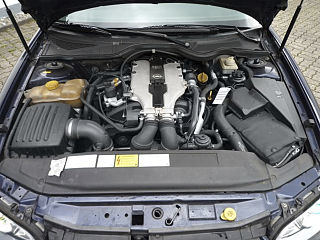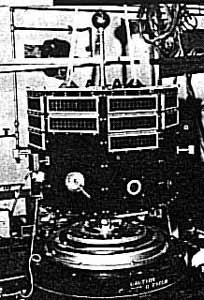Related Research Articles

Pressure measurement is the measurement of an applied force by a fluid on a surface. Pressure is typically measured in units of force per unit of surface area. Many techniques have been developed for the measurement of pressure and vacuum. Instruments used to measure and display pressure mechanically are called pressure gauges,vacuum gauges or compound gauges. The widely used Bourdon gauge is a mechanical device, which both measures and indicates and is probably the best known type of gauge.
In spark-ignition internal combustion engines, knocking occurs when combustion of some of the air/fuel mixture in the cylinder does not result from propagation of the flame front ignited by the spark plug, but when one or more pockets of air/fuel mixture explode outside the envelope of the normal combustion front. The fuel–air charge is meant to be ignited by the spark plug only, and at a precise point in the piston's stroke. Knock occurs when the peak of the combustion process no longer occurs at the optimum moment for the four-stroke cycle. The shock wave creates the characteristic metallic "pinging" sound, and cylinder pressure increases dramatically. Effects of engine knocking range from inconsequential to completely destructive.
The GM Ecotec engine, also known by its codename L850, is a family of all-aluminium inline-four engines, displacing between 1.4 and 2.5 litres. Confusingly, the Ecotec name was also applied to both the Buick V6 Engine when used in Holden Vehicles, as well as the final DOHC derivatives of the previous GM Family II engine; the architecture was substantially re-engineered for this new Ecotec application produced since 2000. This engine family replaced the GM Family II engine, the GM 122 engine, the Saab H engine, and the Quad 4 engine. It is manufactured in multiple locations, to include Spring Hill Manufacturing, in Spring Hill, Tennessee, with engine blocks and cylinder heads cast at Saginaw Metal Casting Operations in Saginaw, Michigan.
An oxygen sensor (or lambda sensor, where lambda refers to air–fuel equivalence ratio, usually denoted by λ) or probe or sond, is an electronic device that measures the proportion of oxygen (O2) in the gas or liquid being analysed.

General Motors' Opel subsidiary in Europe designed a compact V6 engine with an unusual 54° vee angle. It was an iron block/aluminum head DOHC design with four valves per cylinder. All 54° engines were assembled at Ellesmere Port in England.
The Trionic 8 is an advanced engine management system in the Trionic series, created by Saab Automobile. It is used in both Saab 9-3 and Opel Vectra vehicles, and is available with 150, 175 and 210 horsepower (160 kW) engines. It will also be used for a flexifuel version starting production spring 2007. Saab Trionic T8 has been developed by Saab and is a very advanced engine management system. The Engine Control Module (ECM) is used principally to regulated the air mass, fuel and ignition timing.
Lean-burn refers to the burning of fuel with an excess of air in an internal combustion engine. In lean-burn engines the air–fuel ratio may be as lean as 65:1. The air / fuel ratio needed to stoichiometrically combust gasoline, by contrast, is 14.64:1. The excess of air in a lean-burn engine emits far less hydrocarbons. High air–fuel ratios can also be used to reduce losses caused by other engine power management systems such as throttling losses.

A mass (air) flow sensor (MAF) is a sensor used to determine the mass flow rate of air entering a fuel-injected internal combustion engine.
MAFless tuning is a method of operating the fuel injection system on a gasoline-powered motor vehicle whereby the mass airflow meter, or MAF, is removed.

Motronic is the trade name given to a range of digital engine control units developed by Robert Bosch GmbH which combined control of fuel injection and ignition in a single unit. By controlling both major systems in a single unit, many aspects of the engine's characteristics can be improved.
An engine test stand is a facility used to develop, characterize and test engines. The facility, often offered as a product to automotive OEMs, allows engine operation in different operating regimes and offers measurement of several physical variables associated with the engine operation.

In a spark ignition internal combustion engine, ignition timing is the timing, relative to the current piston position and crankshaft angle, of the release of a spark in the combustion chamber near the end of the compression stroke.

Digifant is an Engine Management System operated by an Engine Control Unit that actuates outputs, such as fuel injection and ignition systems, using information derived from sensor inputs, such as engine speed, exhaust oxygen and intake air flow. Digifant was designed by Volkswagen Group, in cooperation with Robert Bosch GmbH.

Saab Direct Ignition is a capacitor discharge ignition developed by Saab Automobile, then known as Saab-Scania, and Mecel AB during the 1980s.
Trionic T5.5 is an engine management system in the Saab Trionic range. It controls ignition, fuel injection and turbo boost pressure. The system was introduced in the 1993 Saab 9000 2.3 Turbo with B234L and B234R engine.
Trionic is an engine management system developed by Saab Automobile. It consists of an engine control unit (ECU) that controls 3 engine aspects:
- Ignition timing
- Fuel injection
- Acts as a boost controller.

An internal combustion engine is a heat engine in which the combustion of a fuel occurs with an oxidizer in a combustion chamber that is an integral part of the working fluid flow circuit. In an internal combustion engine, the expansion of the high-temperature and high-pressure gases produced by combustion applies direct force to some component of the engine. The force is typically applied to pistons, turbine blades, a rotor, or a nozzle. This force moves the component over a distance, transforming chemical energy into kinetic energy which is used to propel, move or power whatever the engine is attached to.

SECU-3 is an internal combustion engine control unit. It is being developed as an open source project. Anyone can take part in the project, and can access all the information without any registrations.

Explorer 31, also called DME-A, was a NASA satellite launched as part of the Explorer program. Explorer 31 was launched on 29 November 1965 from Vandenberg Air Force Base, California, with a Thor-Agena launch vehicle. Explorer 31 was released along with the Canadian satellite Alouette 2.
Manifold injection is a mixture formation system for internal combustion engines with external mixture formation. It is commonly used in engines with spark ignition that use petrol as fuel, such as the Otto engine, and the Wankel engine. In a manifold-injected engine, the fuel is injected into the intake manifold, where it begins forming a combustible air-fuel mixture with the air. As soon as the intake valve opens, the piston starts sucking in the still forming mixture. Usually, this mixture is relatively homogeneous, and, at least in production engines for passenger cars, approximately stoichiometric; this means that there is an even distribution of fuel and air across the combustion chamber, and enough, but not more air present than what is required for the fuel's complete combustion. The injection timing and measuring of the fuel amount can be controlled either mechanically, or electronically. Since the 1970s and 1980s, manifold injection has been replacing carburettors in passenger cars. However, since the late 1990s, car manufacturers have started using petrol direct injection, which caused a decline in manifold injection installation in newly produced cars.
References
- Mecel 20 Years, Göteborg, Sweden – September 1, 2002